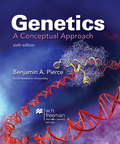
a.
To propose:
The hypothesis to explain the inheritance of kitey, black, and red feather color in pegion.
a.
Explanation of Solution
To investigate the relation between kitey, black and red feather color, crosses were made which are given in following table:
| Cross | Offspring |
| 16 kitey, 5 black, 3 red | |
| 6 kitey, 7 black | |
| 18 red . 9 kitey, 6 black |
Feather color in pigeons are determined by four alleles:
Cross between two pegions carrying kitey
|
(Kitey) |
(Red) | |
|
(Kitey) |
(Black) |
Total number of offsprings observed in the cross
Cross between two pegions carrying black kitey phenotype:
|
(Kitey) |
(Black) | |
|
(Kitey) |
(Black) |
Total number of offspring observed in the cross
Cross between two pegions carrying red and kitey phenotype;
|
(Red) |
(Red) | |
|
(Kitey) |
(Black) |
Total number of offspring observed in the cross
On the basis of the results obtained from the crosses , it can be hypothesized that “
b.
To test:
The hypothesis for each of the preceding crosses using a chi square test.
b.
Explanation of Solution
To investigate the relation between kitey, black and red feather color, crosses were made which are given in the following table:
| Cross | Offspring |
| 16 kitey, 5 black, 3 red | |
| 6 kitey, 7 black | |
| 18 red . 9 kitey, 6 black |
Feather color in pigeons are determined by four alleles:
Cross between two pegions carrying kitey phenotype;
|
Kitey |
Red | |
|
Kitey |
Black |
Total number of offspring expected in the cross
Total number of offspring produced in the cross
To compare the observed number of progenies with the expected number of progenies in cross
The difference between expected number of progenies and observed number of progenies in
Cross between two pegions carrying black kitey phenotype:
|
(Kitey) |
(Black) | |
|
(Kitey) |
(Black) |
Total number of offspring expected in the cross
Total number of offspring produced in the cross
To compare observed number of progenies with expected number of progenies in cross
The difference between expected number of progenies and observed number of progenies in
Cross between two pegions carrying red and kitey phenotype;
|
(Red) |
(Red) | |
|
(Kitey) |
(Black) |
Total number of offspring expected in the cross
Total number of offspring observed in the cross
To compare the observed number of progenies with the expected number of progenies in cross
The difference between expected number of progenies and observed number of progenies in
Considering the crosses and their results, it can be hypothesized that
Want to see more full solutions like this?
Chapter 5 Solutions
Genetics: A Conceptual Approach
- Describe the principle of homeostasis.arrow_forwardExplain how the hormones of the glands listed below travel around the body to target organs and tissues : Pituitary gland Hypothalamus Thyroid Parathyroid Adrenal Pineal Pancreas(islets of langerhans) Gonads (testes and ovaries) Placentaarrow_forwardWhat are the functions of the hormones produced in the glands listed below: Pituitary gland Hypothalamus Thyroid Parathyroid Adrenal Pineal Pancreas(islets of langerhans) Gonads (testes and ovaries) Placentaarrow_forward
- Describe the hormones produced in the glands listed below: Pituitary gland Hypothalamus Thyroid Parathyroid Adrenal Pineal Pancreas(islets of langerhans) Gonads (testes and ovaries) Placentaarrow_forwardPlease help me calculate drug dosage from the following information: Patient weight: 35 pounds, so 15.9 kilograms (got this by dividing 35 pounds by 2.2 kilograms) Drug dose: 0.05mg/kg Drug concentration: 2mg/mLarrow_forwardA 25-year-old woman presents to the emergency department with a 2-day history of fever, chills, severe headache, and confusion. She recently returned from a trip to sub-Saharan Africa, where she did not take malaria prophylaxis. On examination, she is febrile (39.8°C/103.6°F) and hypotensive. Laboratory studies reveal hemoglobin of 8.0 g/dL, platelet count of 50,000/μL, and evidence of hemoglobinuria. A peripheral blood smear shows ring forms and banana-shaped gametocytes. Which of the following Plasmodium species is most likely responsible for her severe symptoms? A. Plasmodium vivax B. Plasmodium ovale C. Plasmodium malariae D. Plasmodium falciparumarrow_forward
- please fill in missing parts , thank youarrow_forwardplease draw in the answers, thank youarrow_forwarda. On this first grid, assume that the DNA and RNA templates are read left to right. DNA DNA mRNA codon tRNA anticodon polypeptide _strand strand C с A T G A U G C A TRP b. Now do this AGAIN assuming that the DNA and RNA templates are read right to left. DNA DNA strand strand C mRNA codon tRNA anticodon polypeptide 0 A T G A U G с A TRParrow_forward
 Human Anatomy & Physiology (11th Edition)BiologyISBN:9780134580999Author:Elaine N. Marieb, Katja N. HoehnPublisher:PEARSON
Human Anatomy & Physiology (11th Edition)BiologyISBN:9780134580999Author:Elaine N. Marieb, Katja N. HoehnPublisher:PEARSON Biology 2eBiologyISBN:9781947172517Author:Matthew Douglas, Jung Choi, Mary Ann ClarkPublisher:OpenStax
Biology 2eBiologyISBN:9781947172517Author:Matthew Douglas, Jung Choi, Mary Ann ClarkPublisher:OpenStax Anatomy & PhysiologyBiologyISBN:9781259398629Author:McKinley, Michael P., O'loughlin, Valerie Dean, Bidle, Theresa StouterPublisher:Mcgraw Hill Education,
Anatomy & PhysiologyBiologyISBN:9781259398629Author:McKinley, Michael P., O'loughlin, Valerie Dean, Bidle, Theresa StouterPublisher:Mcgraw Hill Education, Molecular Biology of the Cell (Sixth Edition)BiologyISBN:9780815344322Author:Bruce Alberts, Alexander D. Johnson, Julian Lewis, David Morgan, Martin Raff, Keith Roberts, Peter WalterPublisher:W. W. Norton & Company
Molecular Biology of the Cell (Sixth Edition)BiologyISBN:9780815344322Author:Bruce Alberts, Alexander D. Johnson, Julian Lewis, David Morgan, Martin Raff, Keith Roberts, Peter WalterPublisher:W. W. Norton & Company Laboratory Manual For Human Anatomy & PhysiologyBiologyISBN:9781260159363Author:Martin, Terry R., Prentice-craver, CynthiaPublisher:McGraw-Hill Publishing Co.
Laboratory Manual For Human Anatomy & PhysiologyBiologyISBN:9781260159363Author:Martin, Terry R., Prentice-craver, CynthiaPublisher:McGraw-Hill Publishing Co. Inquiry Into Life (16th Edition)BiologyISBN:9781260231700Author:Sylvia S. Mader, Michael WindelspechtPublisher:McGraw Hill Education
Inquiry Into Life (16th Edition)BiologyISBN:9781260231700Author:Sylvia S. Mader, Michael WindelspechtPublisher:McGraw Hill Education





